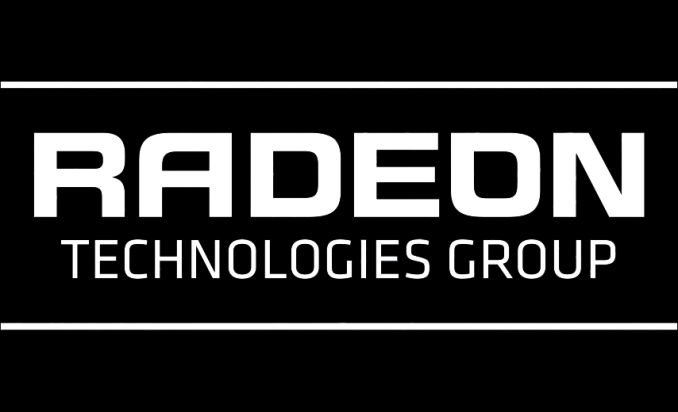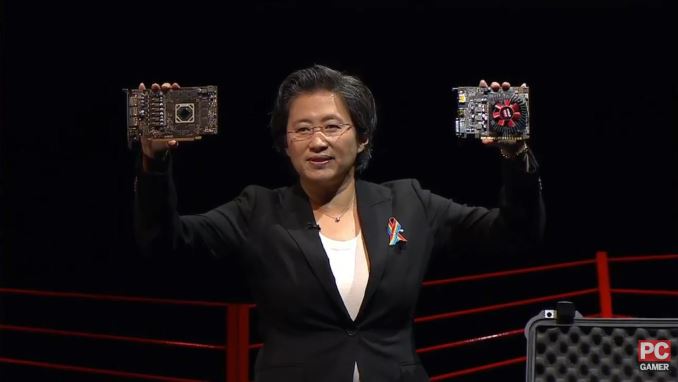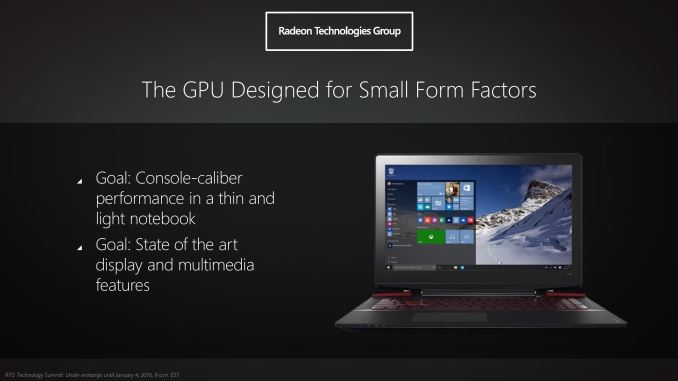AMD Teases Future Radeon RX 470 & Radeon RX 460 Cards
by Ryan Smith on June 13, 2016 3:30 PM EST
With the annual Electronic Entertainment Expo once again upon us, this week has been a flood of gaming hardware and software news. On the PC front, AMD is once again sponsoring PC Gamer’s PC Gaming Show, and while the company isn’t making quite as large of a presence this year – having just announced a bunch of tech at Computex – AMD is still attending E3 to tease a bit of hardware. Announced in a press release that’s going out at the same time as the PC Gaming Show starts, AMD is very briefly teasing the next two Polaris-based Radeon cards: the Radeon RX 470 and the Radeon RX 460.
AMD previously teased the Radeon RX 480 back at Computex, and with that card not shipping until the end of this month, the RX 470 and RX 460 are even more brief teases, essentially amounting to AMD confirming that they will exist.
As you can assume from the numbers, the RX 470 and RX 460 will slot in below the $199 RX 480. AMD’s press release specifically notes that the RX 470 is a “refined, power-efficient HD gaming” card. Whereas the RX 460 is a “a cool and efficient solution for the ultimate e-sports gaming experience.” These are no further details such as performance, specifications, or pricing, so this is a true teaser in every sense of the word.
Based on their admittedly short descriptions, it sounds like the RX 470 and RX 460 will slot in to very similar positions as the R7 370 and R7 360 respectively, as these are the same markets AMD pitched those cards at. This would make the RX 470 a budget 1080p card, while RX 460 is pitched specifically at MOBA players and the like, as those games have relatively low system requirements. Lower-end cards of this nature have also proven very popular in China, where MOBAs are especially popular and the pricing is better aligned with what most consumers can afford.
For what it’s worth, those cards launched at $149 and $109 respectively, so that may give us a ballpark idea of what to expect. Note that AMD only has two Polaris chips – the larger Polaris 10 and the smaller Polaris 11 – so it’s not clear how AMD may split these up. Historically, Radeon x60 cards have been based on chips that have been prevalent in smaller, mid-performance laptops.
On that note there’s one last passage from AMD’s press release I want to point out. In reiterating their talking point about bringing “console-like” performance to thin and light laptops, AMD’s release mentions that Polaris offers “exceptionally low power and low-z height.” Like everything else, no further details are provided, but I don’t suspect this is the last we’ve heard of this point. Having seen a very early Polaris 11 last December it’s definitely a small chip, and it sounds like AMD focused not just on package size, but thickness as well. Z-height is not something I’ve previously paid attention to, so I’m not immediately sure how thick AMD’s last-generation chips were, or whether this has been much of a problem on a competitive basis.












105 Comments
View All Comments
The_Countess - Wednesday, June 22, 2016 - link
the only bias here is your own. YOU don't want a cheap GPU so you think nobody want it. but the fact remains that most discrete GPU sales are sub 300 dollars (and yes that includes both AMD and nvidia)Kjella - Monday, June 13, 2016 - link
Both fine restaurants and McDonald's make money, the key question is price compared to cost. Yes, it's yielding the high end but AMD can't afford to offer a full range of products and they can't afford another "almost good enough" confrontation like with Fury. The leaks indicate GTX980 levels of performance for $199, that's a pretty huge value for all those who won't spend $300+ on a graphics card. If they can get a head start on nVidia, some rave reviews and some decent production volume - smaller chips is easier - they might make some money and live to fight another day. It's not really an ideal plan, but going head-to-head with nVidia right now seems like a bad idea, they need to keep the lights on long enough to launch Zen if they want to save the company.Danvelopment - Monday, June 13, 2016 - link
Did someone say HD 48x0?It's a strategy that works and benefits both the brand and the consumer.
ffleader1 - Monday, June 13, 2016 - link
I can't actually imagine how GTX 1060, whose price range is supposed to be around $200, can beat Rx 480, whose performance according to various leak recently is above GTX 980 and can potentially OC to match 1070.Nvidia is basically doomed at anything below 1070.
MLSCrow - Tuesday, June 14, 2016 - link
TROLLKenLuskin - Tuesday, June 14, 2016 - link
@Wreckage, U R A MORON!The_Countess - Wednesday, June 22, 2016 - link
you're missing the point, the CHOSE to make a mid range card. they're selling is for what they designed it to be sold for.and anybody buying a overpriced nvidia 10x0 card now is frankly extremly dumb. in a few months we're getting vega and whatever nvidia's planning for the 'big card' with over twice as many transistors as nvidia's current high end offering, and they'll be selling it for around what a 1080 goes for right now. Only a fool would get nvidia's price gauging 'high end' card's that aren't high end at all.
Murloc - Wednesday, June 15, 2016 - link
doesn't it make business sense to put out high margin (and thus high end) cards first?Nvidia did this best with their founder's edition cards.
Ananke - Friday, June 17, 2016 - link
No. NVidia primary growth markets are car infotainment/chipsets and high performance computing. In the last several generations they are designing their GPUs targeting the HPC aka supercomputing and taking market from IBM. AMD is nowhere there. NVidia's gaming cards are actually a leftover of the HPC design, hence they start with the high end and scale down. AMD designs are towards consoles, laptop and desktop markets, and maybe HPC/workstaion if there is any demand for their brand - almost zero at the moment.So, NVidia has no reason neither desire to erode its prices, and to release cheap products first, versus AMD that has no market for expensive workstation and HPC class products.
This round this segmentation became very obvious - if your purpose is gaming, money wise it makes sense to buy AMD. Consoles will have AMD, and Apple will have AMD. If you just have a lot of money to throw, or you are a business customer buying workstations - get NVidia. For both of the two, PC market is the least priority in business.
jjj - Monday, June 13, 2016 - link
By the same troll logic, Nvidia cheapest card is 449$.